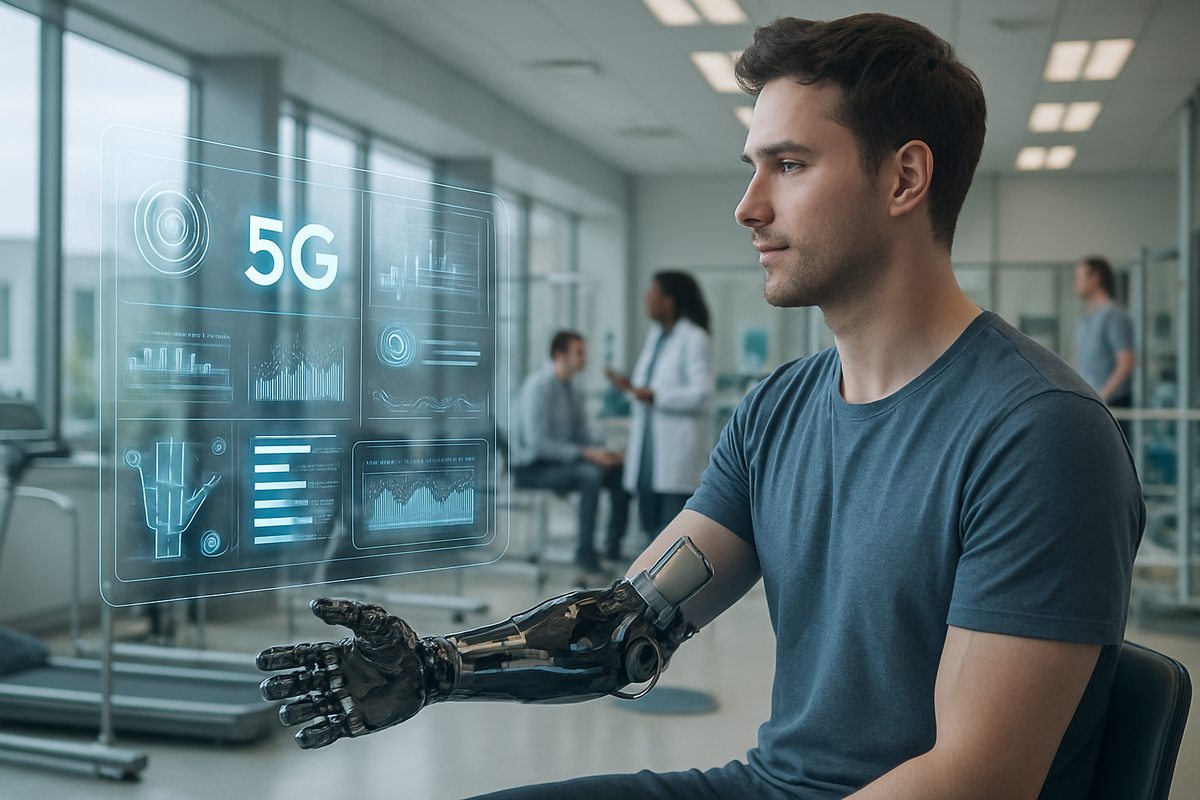The Next Leap for Bionic Limbs: How 5G and Cloud Computing Will Transform Prosthetics by 2030
Discover how 5G and cloud AI are transforming bionic limbs into smart, adaptive devices, promising real-time intelligence and unparalleled mobility by 2030. Explore the future of healthtech and seize opportunities in this exploding market revolution.

Explore how ultra-fast 5G networks and cloud-based AI are revolutionizing bionic limbs, delivering real-time adaptability, enhanced sensory feedback, and personalized mobility for millions of amputees.
Welcome to the Bionic Renaissance
Remember when the word “prosthetic” conjured images of rigid, mechanical limbs and clunky hooks? Fast-forward to 2025, and we’re already witnessing bionic arms that high-five, sense pressure, and even light up like something out of a Marvel movie. But the real superpower isn’t just in the hardware—it’s in the invisible networks and cloud brains that will soon connect every bionic limb to a world of real-time intelligence. If you think today’s prosthetics are high-tech, wait until you see what’s coming by 2030.
“The next generation of bionic limbs will be as connected as your smartphone—smarter, faster, and uniquely tailored to every user, every moment.”
5G + Cloud: A Prosthetic’s Perfect Pairing
Let’s get nerdy for a moment—because the leap from ‘pretty good’ prosthetics to truly intelligent bionics is all about bandwidth and brains. Here’s how:
- 5G Connectivity: Ultra-low latency (think: blink-and-you-miss-it speed) means bionic limbs can send and receive data in real time—critical for instant feedback and seamless movement.
- Cloud Computing: Massive AI models running in the cloud can crunch millions of data points, learn from every user’s unique gait, and update control algorithms on the fly—no need to jam a supercomputer into your elbow.
Together, they enable what researchers call cloud-connected bionics: prosthetic limbs that are always learning, adapting, and getting smarter with every step. Recent proof-of-concept trials in 5G testbeds confirm that this isn’t science fiction—real-time, cloud-based control is already possible and fast enough for natural limb movement.[1]
The New Superpowers: What’s Coming by 2030
1. Real-Time Adaptability
Today’s bionic limbs are already impressive, but their ability to adapt “on the fly” is limited by local processing. With 5G and cloud AI:
- Personalized movement: The limb learns your walking style, grip strength, and even compensates for daily fatigue or uneven terrain.
- Automatic updates: Like your phone, prosthetics will receive over-the-air feature upgrades, bug fixes, and personalized training routines.
2. Enhanced Sensory Feedback
Imagine feeling the difference between silk and sandpaper, or adjusting your grip before you drop your morning coffee. Advanced bionics will use 5G to stream high-resolution sensory data to cloud AI, which then translates it into precise, real-time feedback—restoring a sense of touch and proprioception.
3. Seamless Integration with Smart Environments
Connected limbs will talk to smart homes, vehicles, and even hospital systems. Your bionic hand could unlock your front door, adjust your car seat, or alert your doctor if it detects abnormal strain. Welcome to the age of Internet of Limbs.
Case Study: 5G-Enabled Bionic Limbs in Action
Researchers have already demonstrated that 5G’s ultra-fast, low-latency connections allow bionic limbs to offload heavy computation to the cloud, freeing up the device and making it lighter and more responsive.[2] In one testbed, users experienced:
- Natural, intuitive control of prosthetic hands and arms—even during rapid, complex movements
- AI-driven grip adjustments based on real-time sensor data
- Personalized settings that adapt as the user moves from walking to running to cycling
As one early adopter put it, “It’s like my bionic arm finally understands me. And it’s getting smarter every week.”
The Startup Gold Rush: Opportunities for Innovators
If you’re an entrepreneur, investor, or developer with a passion for healthtech, this is your golden hour. The connected bionics market is exploding—with projected global growth rates exceeding 10% annually through 2030.[3]
- Wearable Tech & Sensors: Next-gen sensors for pressure, temperature, and muscle signals are in high demand.
- AI & Cloud Services: Startups that build adaptive control algorithms, cybersecurity for medical devices, or cloud platforms for remote prosthetic management are attracting major VC attention.
- 5G Infrastructure: Telecoms and edge computing providers are racing to support medical-grade, always-on connectivity for prosthetic users.
- Rehabilitation & Data Analytics: Clinics and healthtech software companies are leveraging big data to personalize therapy and track outcomes in real time.
TL;DR: If you’ve got a smart idea, there’s funding and a global audience waiting.
Challenges on the Bionic Horizon
Of course, it’s not all smooth sailing. Key hurdles include:
- Privacy and Security: Protecting highly personal health data in the cloud is non-negotiable.
- Reliability: A lost signal or a cloud outage can’t leave someone stranded—hybrid local/cloud designs are essential.
- Accessibility: Making these high-tech limbs affordable and available worldwide, not just in wealthy clinics, is the next great challenge (and opportunity).
What Will Life Look Like in 2030?
By the end of this decade, expect to see prosthetic limbs that:
- Feel and move like a natural part of the body
- Automatically adapt to the user’s needs, environment, and health status
- Connect seamlessly to smart homes, vehicles, and healthcare systems
- Continuously improve with cloud-based AI learning from millions of users worldwide
Whether you’re an amputee, a clinician, an investor, or simply a fan of sci-fi come to life, the connected bionics revolution is happening now. The only question: will you watch it, or help shape it?
Want to stay on the cutting edge of bionics, AI, and the future of healthtech?
Become a Funaix Insider—subscribe for free and get smart news, perks, and access to our exclusive comment community. (Pssst: Only subscribers can read and write comments. And yes, it’s free—for now!)
References & Further Reading
- Ozan Karaali et al., "Enabling Next-Generation Cloud-Connected Bionic Limbs Through 5G Connectivity," arXiv:2506.11744, June 2025.
- Future Market Insights, "Medical Bionic Implant and Exoskeleton Market Outlook 2025 to 2035," futuremarketinsights.com, June 2025.
- Global Growth Insights, "Medical Bionic Implants Market Report," globalgrowthinsights.com, July 2025.




